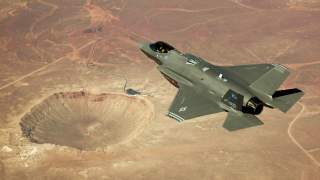The F-35 Can Now Fight a Ground War
Raytheon is expected to deliver a total of 1,200 GBU-49 guidance kits, test hardware, logistics and engineering support and technical data to support the F-35 program.
The United States Air Force is adding the ability to attack moving targets to its new Lockheed Martin F-35A Joint Strike Fighter with the addition of the 500lbs Raytheon GBU-49 Enhanced Paveway II laser-guided bomb.
"Fielding the GBU-49 for use on the F-35A is a key milestone in delivering combat capability to the warfighter," Brig. Gen. Todd Canterbury, director of the Air Force F-35 Integration Office, said in a statement.
"The F-35 is operational and combat ready, and integrating the GBU-49 with the aircraft makes the F-35 even more lethal than it already is."
As originally envisioned, the single-engine stealth fighter did not include the ability hit moving targets with a laser-guided weapon in its Block 3F software load. Even though F-35s equipped with the final Block 3F configuration have the ability to identify and track multiple moving ground targets, when the Pentagon originally set the requirements for what became the Joint Strike Fighter program, the idea was that pilots would use cluster munitions to engage those enemies. However, since the Convention on Cluster Munitions (CCM) was adopted in 2008, such weapons have fallen out of vogue. The United States is not a signatory to the treaty, but Washington abides by the provisions of the document for the most part.
Recommended: This Video Shows What Happens if Washington, D.C. Is Attacked with Nuclear Weapons
Recommended: 8 Million People Could Die in a War with North Korea
Recommended: Why North Korea Is Destined to Test More ICBMs and Nuclear Weapons
Because Washington does abide by the CCM treaty—for the most part—the Pentagon needed a solution to hit moving targets from the F-35 without resorting to cluster bombs or the pilot manually adjusting a laser-guided bomb like the GBU-12— which is an earlier version of the GBU-49—to hit those targets.
To that end, the U.S. Air Force awarded Raytheon a $59.7 contract to buy the GBU-49 Enhanced Paveway II for the F-35. According to the Air Force, the addition of the GBU-49 “will enable the F-35A to strike moving targets when integrated with the aircraft's Software Block 3F until Laser Joint Direct Attack Munitions and Small Diameter Bomb II munitions are integrated in later software releases.”
Raytheon is expected to deliver a total of 1,200 GBU-49 guidance kits, test hardware, logistics and engineering support and technical data to support the F-35 program. "This contract award represents great teaming across the entire government and industry enterprise," Brig. Gen. Anthony Genatempo, Air Force program executive officer for weapons, said in a statement.
The Air Force expects to start flight-testing of the GBU-49 with the F-35A this month—December 2017. If all goes according to plan, the Air Force will receive an initial 400 guidance kits by the end of January 2018. The Air Force is able to move remarkably quickly on integrating the new weapon onboard the F-35 because it is so similar to the GBU-12, which is its direct predecessor.
That fact is that the Air Force had little choice but to accelerate the fielding of a weapon that can engage moving targets. While the F-35 was designed to fight a future version of the 1991 Persian Gulf War—which was the thinking that the time the requirements were set—the fact is that these days the fighter will just as often be targeting insurgents over Syria or Afghanistan, where even the stealthy high-flying Lockheed Martin F-22 Raptor air superiority fighter has been pressed into service to strike a drug lab in recent days.
As such, the Air Force needs to get ability to hit moving targets it might encounter in such theaters into service onboard the JSF as soon possible. With a planned buy of 1,763 F-35A Lightning II aircraft—which attained a rudimentary initial operational capability in August 2016—is set to become the mainstay of American airpower. Thus, sooner is better in this case.
Dave Majumdar is the defense editor for the National Interest. You can follow him on Twitter: @davemajumdar.
Image Credit: Creative Commons/Flickr.
Recommended: 5 Most Powerful Aircraft Carriers, Subs, Bombers and Fighter Aircraft Ever
Recommended: North Korea Has 200,000 Soldiers in Its Special Forces
Recommended: Why Doesn't America Kill Kim Jong Un?

